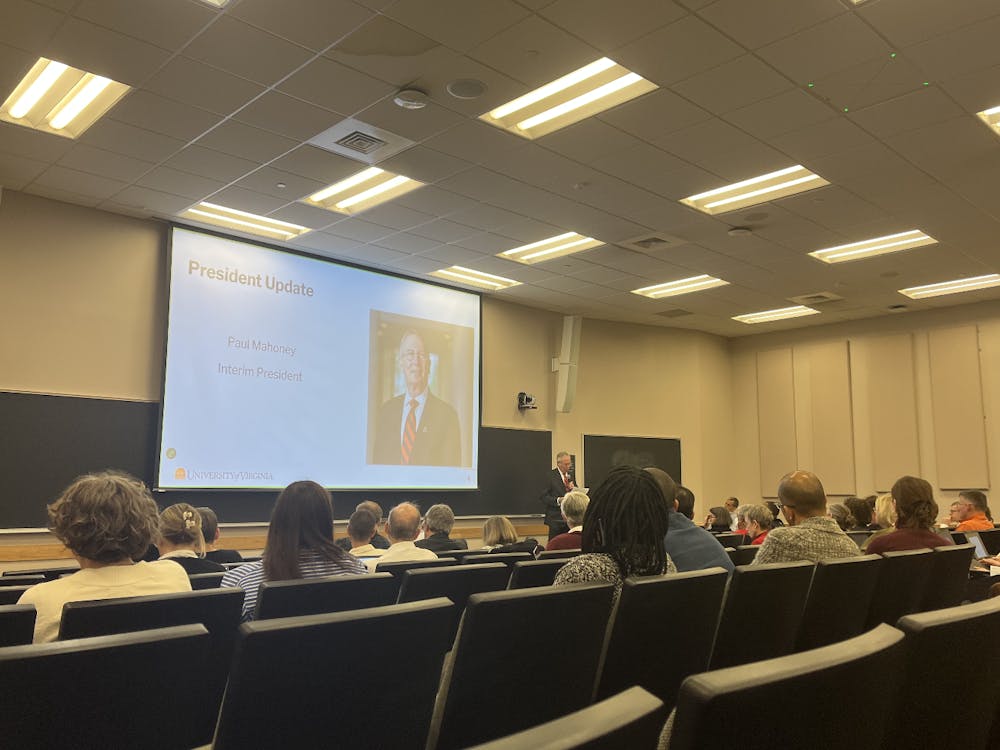Minus irascible brokers shouting amidst the torrent of flying paper, walk into the University's newest classroom and you may think you've stepped onto the floor of the New York Stock Exchange.
Promising to revolutionize the way the University teaches business and finance, the Bridge Trading Center was inaugurated Thursday in a reception at the Commerce School. Keynote speaker Tom Wendel, Chairman and CEO of Bridge Information Systems, launched the facility by cutting the ceremonial ribbon and outlining the vision of the Bridge Trading Center.
The trading center, located on the ground level of Monroe Hall, is an accomplishment of University architect Eugenio Schettini, who said he wanted to compensate for the rigid, angular feel of technology by softening it with wall and ceiling curves.
But no less an achievement is the trading center's intended purpose - to provide live coverage of world markets and the tools to perform in-depth financial analysis, To that end, the Center features 62 Telerate financial workstations, IBM direct servers, flat-panel display screens and an elliptical tickerboard, one of only two in the U.S. Elliptical tickerboards allow all students in the room to view the tickerboard simultaneously.
"Up until a couple of weeks ago, I didn't even know what half of this stuff was for," joked Commerce School Dean Carl P. Zeithaml.
Zeithaml said the Bridge Trading Center is state-of-the-art, and one of only a few of its kind.
"The technology involved here is so advanced that when I suggested that we were creating an environment in which graduates could make a seamless transition into the business world, a couple of Wall Street recruiters, upon visiting the center told me, 'Actually, coming out of here, students would have to make a step down,'" he said.
As a string quartet played Vivaldi's "Spring" amid enthusiastic students and faculty at the center's inaugural reception, Commerce professors demonstrated how the new technology would be put to use.
The trading center will be used by the Commerce School to demonstrate more effectively the validity and practical application of financial theory, conduct studies on risk analysis, and evaluate companies. It also will be used by student organizations such as the McIntire Investment Institute to track performance of portfolios and various financial strategies.
"The trading center may go as far as to change the way the entire core curriculum is taught," said Bob Webb, senior assoc. dean of the Commerce School.
From a learning perspective, students will be able to use the trading center as an analytical tool to enhance what they have learned in the traditional classroom. Students, because they will now have immediate access to realtime financial data, can make more informed decisions from how certain equities are performing to identification of arbitrage opportunities, to how market phenomena affects corporate behavior.
The Bridge Trading Center also will broaden the range of research data available to students and faculty, and therefore more accurately test theories.
From a research perspective, the trading center provides the opportunity to generate experimental data to test various financial theories and to examine how the market responds.
"In business school, we teach theories. At the same time, however, we know that financial theory and practice do not perfectly correlate because of market frictions. The data we have available to us now will help us to create better, more accurate theories," said Asst. Finance Professor Pat Dennis.
Dennis said he will be able to use the new software to further his research on the Nobel prize winning anomaly of the Volatility Smile. The Volatility Smile is a theory that a stock becomes less volatile as its value increases.
Management Information Systems Professor Dave Smith said the trading center will assist his teaching of how data can be presented in a way that adds the most value to an operation.
"One of the greatest benefits to the students will be the ease with which the Telerate data can be transferred into spreadsheet data like Microsoft Excel. I liken it to a sandbox, where students are apt to learn more because they can get the data and play with it," Dennis said.
Bridge Information Systems, based in New York, is one of the fastest-growing brokerage information providers, with annual revenues exceeding $1 billion. The donation to the McIntire School forms part of the Bridge University Program, which began contributing services toward the professional development of finance students at a select group of universities in 1987.






